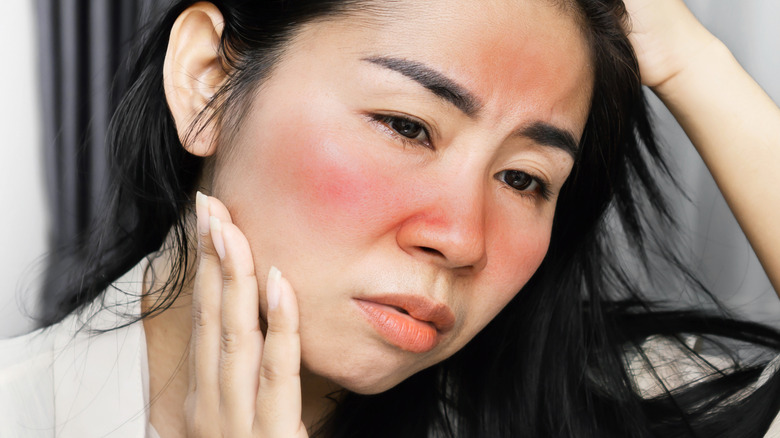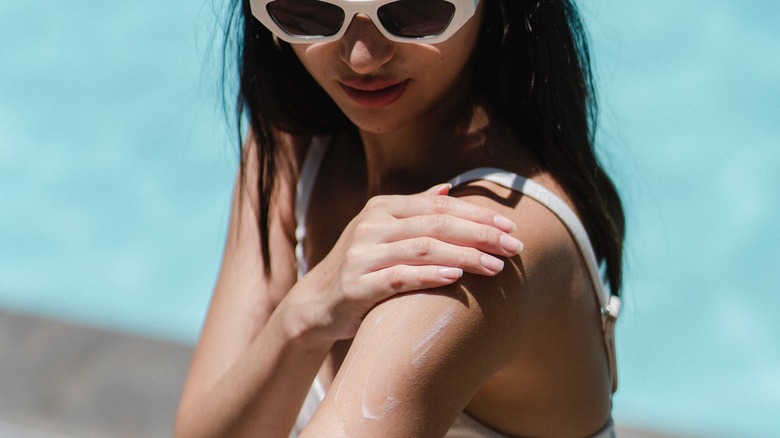How Long Does It Take For A Sunburn To Heal?
There's a lot to expect from a weekend vacation by the beach. Tanning on the sand. A good surf on the ice-cold waves. And the not-so-pleasant part: sunburn. Sunburn, per The Skin Cancer Foundation, is inflamed skin caused by ultraviolet (UV) radiation that penetrates the skin's outermost layers as a result of prolonged exposure to the sun. Indoor tanning, such as tanning beds, that adopt UV radiation to create a cosmetic tan can also give you sunburn.
Any part of your body that's exposed to excessive UV rays for long hours can get burned, including your eyes. "It's called photokeratitis," said ophthalmologist Todd Altenbernd (via Banner Health). Swelling, pain, itching, fluid-filled blisters, peeling, gritty eyes, and even fever, are some common signs of a sunburn. About one-third of American adults get sunburn every year, and more than 33,000 of these burns necessitate trips to the emergency department, the National Cancer Institute warns. Most of the time, sunburn goes away on its own, but the healing speed might vary from person to person. Here's why.
A mild sunburn usually disappears in three to five days
According to the American Cancer Society, people with naturally darker skin are less likely to get sunburnt because their bodies produce more pigment melanin that shields their skin from UV rays. Meanwhile, those with pale skin are at higher risk of getting a burn. Sunburns can heighten your risk of skin cancer, including melanoma, a form of skin cancer primarily caused by overexposure to damaging UV rays or tanning beds. Getting a sunburn doesn't always mean you'll get skin cancer. But the more times you get burned, the higher the risks of melanoma skin cancer you'll get. The DNA of skin cells is disrupted when UV radiation penetrates the skin, which might result in irreversible genetic changes and facilitate the growth of skin cancer cells.
Symptoms of a mild sunburn often go away in three to five days, per the Centers for Disease Control and Prevention. More serious burns take a few weeks to recover. Most of the time, how quickly your sunburn heals depends on your genetics, existing health conditions, and lifestyle habits. Some conditions that slow down your healing include diabetes, smoking, malnutrition, obesity, and chronic stress. There are no quick fixes for sunburn or ways to undo the sun damage. Nonetheless, there are several ways to treat a mild sunburn as well as minimize the risks of getting one.
How to treat and avoid sunburn
To treat sunburn, take a cool shower to relieve the pain and follow up with a moisturizer containing aloe vera or soy to soothe the affected skin and ease the dryness (via the American Academy of Dermatology Association). If the burned skin is too uncomfortable, apply hydrocortisone cream, a corticosteroid used to alleviate itchiness and swelling. Taking aspirin or ibuprofen also aids in relieving discomfort. A sunburn can make you dehydrated, so take care to drink extra water to prevent going into shock. Until your sunburn completely heals, refrain from going out into the sun without covering up your skin. A sunburn may look and feel like a minor blister, but it can cause long-lasting damage to your skin.
To protect your skin from UV ray damage and reduce your risk of developing skin cancer, apply sunscreen at least 30 minutes before going outside. Don't be fooled by an overcast day when you don't see the sun shining, because up to 80 percent of UV rays can still penetrate clouds and reach your skin. For broad-spectrum protection, choose a sunscreen that has an SPF of 30 or higher, The University of Texas MD Anderson Cancer Center advises. You can also give your skin extra protection by covering it up with hats, sunglasses, and UV-protective outfits.


